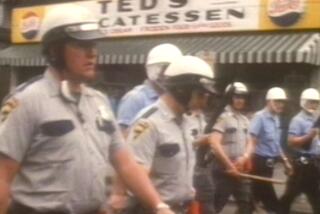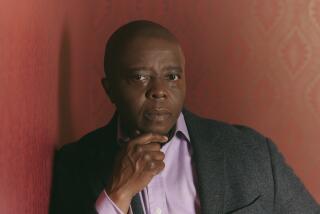Review: ‘Rest in Power: The Trayvon Martin Story’ looks at the how the unarmed teen’s fatal shooting changed a nation
Social justice, personal loss, systemic racism and national reckoning are explored in “Rest in Power: The Trayvon Martin Story,” a potent, moving six-part documentary offering fresh insight into the 2012 killing of unarmed teen Martin by 28-year-old vigilante George Zimmerman.
The docu-series chronicles why this slaying of a young black man — a crime that often goes uncovered in the media — made headlines, inspired protests, moved a president and forced a national reckoning.
Premiering Monday on BET and the Paramount Network, “Rest in Power” delves deep into the specifics of the 17-year-old’s homicide, the police investigation, the trial and the acquittal. But it’s the way in which directors Jenner Furst and Julia Willoughby Nason connect new and old details of the case with its wide-spread effect that makes “Rest in Power” a comprehensive, emotional and brutally honest look at America since that fatal shooting.
And it’s been a wild ride through one of the more tumultuous periods in modern American history. Martin’s killing and Zimmerman’s acquittal helped ignite social justice movements such as Black Lives Matter, galvanized alt-right advocates around issues of white separatism and ultimately influenced the outcome of the 2016 presidential election.
The series, inspired by a 2017 book by Martin’s parents, Sybrina Fulton and Tracy Martin (they co-produce the series along with Shawn “Jay Z” Carter), uses the scope of history to string together all these events as well as the ensuing protests over the shootings of unarmed black men and women across the country.
Perhaps its no coincidence that PBS is airing the POV documentary “Whose Streets?” about the uprising in Ferguson, Mo., after the killing of unarmed Michael Brown by a law officer, police brutality and justice on the same night as “Rest in Power.”
But for all the interviews in “Rest in Power” with Martin’s parents, Zimmerman’s friends (he and his family refused to participate in the film), cops, prosecutors, lawyers and civil rights advocates, it’s a few seconds of the 911 recording from that night in February 2012 that prove to be the most haunting. They reveal the last brutal moments before Martin’s hoodie became a symbol of injustice and Zimmerman became a hero of white separatists.
It’s a recording of Zimmerman’s 911 call from his car as he follows Martin, who is walking through the gated Florida community where Zimmerman lived and where Martin is visiting. Zimmerman was armed with a 9-millimeter semiautomatic handgun. Martin was armed with a bag of Skittles and a can of Arizona ice tea he’d just purchased from a 7-Eleven.
Zimmerman tells the 911 operator: “He’s got his hand in his waistband.” “He’s wearing a hoodie.” “He’s a black man.” “These ..., they always get away.” “He’s running!”
“Are you following him?” asks the operator. Zimmerman answers yes. The operator advises him not to do that. He does anyway.
Martin’s terrified, guttural scream of “Help!,” heard in the background of another 911 call made by a concerned resident, is the sound of homicide in real time. The last moments of a young man’s life. It’s brutal.
“I’ve got the shooter, and I’ve got the gun,” says a police officer who was on the scene that rainy night. “An arrest seemed imminent.”
Yet it took months, so Martin’s parents enlisted civil rights attorney Benjamin Crump, who advised them that they “better make it as public as possible or they’re just gonna sweep it under the rug” like all the other slain young black men whose families never got justice. And so began the media blitz to draw attention to their case.
As for Zimmerman, we learn that his wife left him days before the shooting partly due to his anger issues that he’d made dozens of other 911 calls in the past about “suspicious” black men in his neighborhood and that he’d been arrested before for resisting arrest.
Yet it was largely Zimmerman’s version of the story that became the narrative for what happened that night, and it was Martin’s reputation that was put on trial. The teen smoked weed. He flipped the bird in a photo posted on social media. He wore a gold grill like those rappers wear.
It’s infuriating and hard to watch. There is no way around the heartbreak and pain here, and that’s likely the point. It’s this lopsided sense of justice that drove the better part of America to march and rekindle a kind of activism not seen since the 1960s and 1970s.
Facing one of the ugliest chapters in a decade full of them probably doesn’t sound all that appealing right about now, but “Rest in Power” is worth the watch.
Martin’s parents, however, are reminders of resilience in the face of adversity. They not only lost their son but they also were and still are threatened by Zimmerman supporters.
The docu-series reveals that Zimmerman, who auctioned off the gun he used to shoot Martin for a reported $250,000, made numerous threats to the show’s producers and a private investigator hired by the production.
When Martin’s mother says, “It took my son being shot down for me to stand up,” she and this series make it clear that her boy’s death was not in vain.
‘Rest in Power: The Trayvon Martin Story’
Where: BET and Paramount
When: 10 p.m. Monday
Rating: TV-14 (may be unsuitable for children under the age of 14)
More to Read
The complete guide to home viewing
Get Screen Gab for everything about the TV shows and streaming movies everyone’s talking about.
You may occasionally receive promotional content from the Los Angeles Times.







